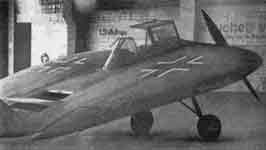 |
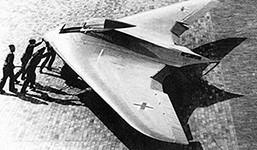 |
separated at birth - the Sack saucer and the Horten flying wing |
The Sack AS 6
The Real "Nazi Saucer?"
For decades, a rich mythology has developed around the claim that Nazi Germany's engineers secretly developed one or more super-sophisticated saucer-shaped aircraft and unmanned disc-like missiles, and that this technology was appropriated by the US or the Soviet Union in the post-war period. The names Schriever, Miethe, Habermohl, Belluzzo are associated with some of these stories, and the locations of the secret plants where these craft were allegedly built range from Prague to Stettin to shadowy underground factories in the legendary "Nazi southern redoubt."
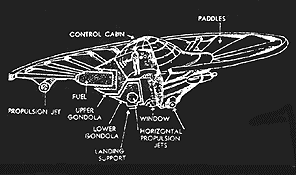 |
|
But according to researchers Hans J. Ebert and Hans Justus Maier, the real creator of the "Nazi flying saucer" - a vehicle which can be shown to have had links to the US Air Force's investigation of UFOs in the post-WWII period - was a farmer from the Leipzig region who had an avid interest in model airplanes. His name was Arthur Sack.
In July 1938, as Ebert and Maier explain it, Sack had entered a competition called the "First Reich-Wide Contest for Motorized Flying Models" in Leipzig. The object of the contest was a simple closed-loop flight from one point and back again, but in those days of primitive model control systems, most of the entrants were unable to persuade their creations to lift off, let alone complete the course. Sack's unique contribution was the use of a circular wing.
The rationale behind the design is unknown -- like some other circular or semicircular aircraft, such as Snyder's Arup, it may have been initially an aesthetic whim -- but in any case the model displayed the STOL performance characteristic of the planform. With a single tail fin and a conventional horizontal stabilizer for pitch control, the AS 1 looked a bit more like the Arups than Zimmerman's Vought V-162. Its wing was about four feet in diameter; it weighed about 10 pounds and was powered by a 30 cc gasoline engine. Sack and his model might have faded into obscurity if one of the most important figures in the German military aircraft establishment had not happened to drop in on the contest. Ernst Udet, the Generalluftzeugmeister (chief of armaments procurement) of the Luftwaffe, was impressed by the short takeoff and landing runs of the model.
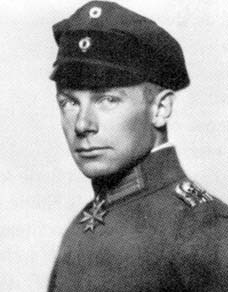 Udet
(an expert pilot and maverick who would shortly become one of the most
enthusiastic high level supporters of Lippisch's Me-163 Komet rocket
fighter) had been interested in STOL aircraft since Gerhard Fieseler had
developed a gangly three-seat observation craft called the Storch
(Stork) to meet a 1935 Luftwaffe requirement for a light tactical reconnaissance
and ground attack plane which could use very short airstrips. The specification
resulted in some interesting proposals: a helicopter-like Focke-Wulf autogyro
and a Messerschmitt design using a tilting wing. But the Storch
was the hands-down winner. To achieve extremely short takeoff and landing
distances Fieseler's designers used an aerodynamic technique almost diametrically
opposed to Zimmerman's theory: the Storch's long, thin wing was
a flying venetian blind, endowed with large slats and flaps to coax the
airflow into generating useful lift even at very slow speeds. Under normal
conditions, a Storch could take off in a little over 80 yards; in a strong
headwind, it could almost hover, dropping gently to a touchdown like a
seagull landing on a post. Perhaps Udet, knowing of the STOL potential
of circular wings, saw the same possibilities in Sack's disk plane.
Udet
(an expert pilot and maverick who would shortly become one of the most
enthusiastic high level supporters of Lippisch's Me-163 Komet rocket
fighter) had been interested in STOL aircraft since Gerhard Fieseler had
developed a gangly three-seat observation craft called the Storch
(Stork) to meet a 1935 Luftwaffe requirement for a light tactical reconnaissance
and ground attack plane which could use very short airstrips. The specification
resulted in some interesting proposals: a helicopter-like Focke-Wulf autogyro
and a Messerschmitt design using a tilting wing. But the Storch
was the hands-down winner. To achieve extremely short takeoff and landing
distances Fieseler's designers used an aerodynamic technique almost diametrically
opposed to Zimmerman's theory: the Storch's long, thin wing was
a flying venetian blind, endowed with large slats and flaps to coax the
airflow into generating useful lift even at very slow speeds. Under normal
conditions, a Storch could take off in a little over 80 yards; in a strong
headwind, it could almost hover, dropping gently to a touchdown like a
seagull landing on a post. Perhaps Udet, knowing of the STOL potential
of circular wings, saw the same possibilities in Sack's disk plane.
According to Maier and Ebert, Udet unofficially encouraged Sack to pursue the development of his design for observation missions or light ground attack duty. But Sack was no Gerhard Fieseler or Charles Zimmerman. During the course of the war he built four more models, about which little is known, and five years would pass before he decided to make the leap to constructing a piloted, full-scale aircraft. While there is no evidence that Sack was directly influenced by the V-173, it is interesting that he began work on his piloted craft in late 1943, when the Flapjack's test flights were beginning. Sack enlisted the help of an engineer from "MiMo" (Mitteldeutsche Motorenwerke, an aircraft subcontracting company located at Brandis Airfield) to calculate structural loads and design the plane's airframe, and persuaded other Brandis workshops to fabricate its components.
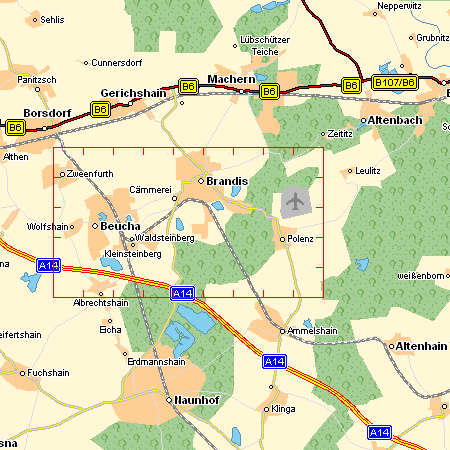 |
Brandis is a small town a few miles southeast of Leipzig. Just east of the city was a large airfield. Flugplatz Brandis was the location of satellite factories where components of various types of aircraft were fabricated. Its very large runways made it ideal as a flight test and fighter base. When Allied bombing raids threatened the crucial Leuna synthetic oil plant near Leipzig, a squadron of 600 mph Messerschmitt Me-163 rocket-powered interceptors was transferred to Brandis to provide defensive cover |
By early 1944 the AS 6 took shape. Its circular fabric-covered wing was about 21 feet in diameter. An Argus AS 10 engine of 240 hp -- the same type used in the Storch -- drove a single two-blade wooden propeller. The wing was equipped with ailerons for roll control, and a large flap was set into the wing just in front of the squat vertical fin, which was stencilled with a Swastika and the letters "AS 6/V1." A simple canopy with flat transparencies was provided for the pilot. Stocky, non-retractable landing gear betrayed the limited performance envelope of the machine. What the AS 6 lacked in the sophisticated drag-reducing features of the V-173 it compensated for with brute force: it possessed fifty percent more horsepower, but weighed just over half as much as its American counterpart.
The plane was finally ready for testing in April 1944. Sack had convinced a pilot named Baltabol, the chief pilot for ATG, a Junkers subcontractor at the base, to try out the peculiar machine. Baltabol soon found out that the AS 6 was poorly built and had vicious handling qualities. The little disk swerved back and forth across the runway as he desperately tried to maintain control by alternately slamming the rudder pedals from one stop to the other. Five times he ran the AS 6 up and down the long Brandis field, veering from side to side. One of the overstressed landing gear struts finally snapped and brought the session to an end. Baltabol realized that the plane was badly designed and would need to be modified to have satisfactory handling.
On April 16, after some rework, the AS 6 was again rolled out, this time with the object of actually achieving flight. The plane was pushed to the very end of the runway. It was dead calm; no crosswinds would complicate steering. Baltabol opened the throttle of the Argus and the craft surged ahead. But to his annoyance, after speeding along for a quarter mile the airplane showed no inclination to lift off. He pulled back on the stick. In another 300 feet, it finally started to bounce. The bouncing rapidly diverged into severe porpoising. The end of the runway loomed, and he finally aborted the run. Another attempt gave similar results, but this time, on one of the bounces, the propeller struck the ground and shattered. The AS 6, lacking the meticulous development of the V-173, apparently had some serious design flaw.
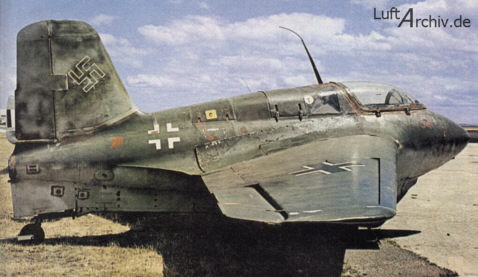 |
The
swept-wing Me-163 was powered by a liquid-fuel rocket engine and
had a phenomenal rate of climb. Capable of speeds approaching Mach
1 in level flight, the Me-163 had the potential to inflict heavy
damage on US bomber raids, but its exotic and highly dangerous fuels
and limited endurance reduced its effectiveness. US and Soviet technical
intelligence analysts were highly interested in the Me-163 and both
sides based early post-war interceptor projects on its technology.
The designer of the radical tailless plane, Alexander Lippisch,
was one of the first technicians relocated to Wright Field under
"Project Paperclip" after the war
|
The German disc plane languished at the base until the summer of 1944, when an Me-163 Komet rocket-powered interceptor squadron, JG 400, was deployed to the base to provide cover for the Leuna synthetic oil plant near Leipzig. Sack soon approached the unit's commander, Hauptmann Robert Olejnik, begging him to let one of his "right stuff" pilots give the AS 6 another try. Olejnik was on the spot:
[Sack] had made contact with my pilots with the aim of winning one of them over to attempting the first flight...and one of my best and most energetic pilots, [Oberleutnant] Franz Rössle, [one of the five pilots who had made the historic encounter with the US Mustangs over Merseburg], a real daredevil, had agreed to undertake this. After days of contemplation and some hot debates with all my pilots, I finally agreed to let Rössle make taxying trials. Taxying trials on the runway proceeded quite well, but as soon as Rössle began further trials on grass, a wheel ran into a molehill [sic] and the leg was bent.
The AS 6, a flawed and now crippled anomaly, was a very low priority project in the hectic closing months of the European war. In all probability it was dragged to some out of the way corner of the base and abandoned.
As the war ground on, German aircraft firms had fewer and fewer safe refuges to test new aircraft. Bombing raids and the progress of the Allied fronts forced Junkers to transfer some of its experimental aircraft to Brandis. About the time the Me 163 unit arrived at the base, Junkers was beginning experiments with a transonic jet test bed called the Ju 287 V1, the world's first forward-swept-wing bomber. On August 16, the big bomber thundered off the Brandis runway for the first time. One of the strangest looking airplanes ever built, it had two jet engines mounted in pods on either side of the nose, two more under the wings, and fixed landing gear enclosed in gigantic fairings. While testing progressed, construction of two more prototypes- the Ju 287 V2, and the definitive six-engine production version, Ju 287 V3, began at the base.
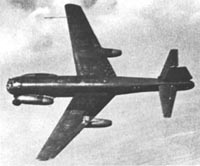 |
Ju
287 V1 in flight near Brandis
|
 |
Horten H 9 V1 glider |
By early 1945, the inevitable end was closing in on Nazi Germany. Crushed between the Americans and British on the West and the Soviets on the East, pounded night and day by air assaults, the Reich was quickly consuming its last reserves of critical resources. To JG 400, this meant that supplies of the special liquid fuels for its Komets were dwindling to a trickle. In desperation, the Luftwaffe hatched a plan to reequip the squadron with the Gotha 229 production version of the Horten H 9 turbojet flying wing interceptor. For training and familiarization, some Horten H 7 two-engine trainers and the H 9 V1 glider prototype were shipped to Brandis. But time was running out. In mid-April US troops overran the Gotha factory and discovered a handful of the half-finished Horten fighters. The heavily defended Leuna chemical plant was captured on the 16th; Leipzig fell on the 19th. By high-level prearrangement, US forces would hold at the Elbe river and await the arrival of the Red Army from the east. Brandis would be reached first by the Americans. It was April 20th -- Hitler's last birthday -- when units of the US Army's 9th Armored Division entered Brandis. There were still pockets of heavy resistance in the area, and they rolled cautiously into the giant airbase, wary of hidden surprises. They must have been amazed at the aeronautical wonderland they found. The retreating Germans had hastily sabotaged many of the planes, but enough remained intact to give the GIs a hint of what had been accomplished. More than a hundred Komets had been delivered to the base. Many rested under camouflage netting in the surrounding woods. Railroad tank cars designed for exotic rocket fuels sat on sidings. In the Junkers shops, the soldiers discovered the half-completed Ju 287s, with their strange, forward-angled wings. In another hangar, surrounded by demolished Me 163s, the partially disassembled Horten H 9 V1 stood on jackstands. Other Horten flying wings were parked nearby. The Americans had little time for sightseeing. A few pictures were taken: anonymous young GIs gawking in awe at Buck Rogers flying machines.
The front moved on, pushing east. The US Army's V Corps met Red Army units at Torgau, on the Elbe, on the 25th. Did the US Army discover a small disk-shaped airplane at Brandis? Unfortunately, the fate of the AS 6 remains a mystery. Maier and Ebert mention a report that a small yellow disk-winged airplane was seen at a military airfield in Munich in the autumn of 1944, but there is no way of knowing whether it was the AS 6, some completely unrelated project, or just a rumor. The first public revelation of the existence of the AS 6 did not come until 1973, in spite of decades of flying saucer publicity and the fact that many of the Komet pilots had thoroughly documented their activities at Brandis. When photographs of the AS 6 finally surfaced nearly thirty years after the war, it would be through these former JG 400 pilots.
The Soviet Zone of Occupation, defined by the leaders of the victorious Allies, swallowed up Brandis and its remaining treasures in July 1945. Like the other Nazi aeronautical facilities that fell into Soviet hands, Brandis was stripped clean of its equipment and aircraft. Anything useful was shipped east for study. Three years later, someone furtively snapped a photo of an unusual jet bomber parked at the Ramenskoye experimental flight test center outside Moscow. The blurry negative made its way into the hands of western intelligence analysts. They were disturbed by what they saw. The futuristic jet was the Ju 287 V3. What else had the Soviets retrieved from Brandis?
From the point of view of researchers who are attempting to flesh out the early history of the US Air Force involvement with UFO research, what makes the Brandis episode interesting is the coexistence of a number of Horten prototypes with the Sack "saucer" at the same base as the exotic Me-163 rocket fighters and other experimental jet prototypes late in the war. The Horten H 9 V1 glider was a forerunner of a 600 mph jet fighter. Intelligence personnel may have wondered if the crude Sack plane was a prototype of a jet or rocket-powered operational version with similar high performance. From about September 1947 to late Spring 1948, Air Force Technical intelligence and counterintelligence forces produced documents that exhibited concerns that Horten designs had influenced the Soviets, who, it was feared, might have developed a highly advanced flying-wing reconnaissance aircraft capable of supersonic speed and intercontinental range.
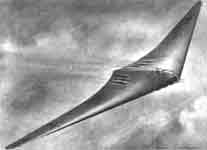 |
The Horten H 18 strategic jet bomber concept of 1945 |
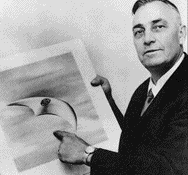 |
Kenneth Arnold with artist's conception of one of the unidentified aircraft he sighted in Washington State in June 1947 |
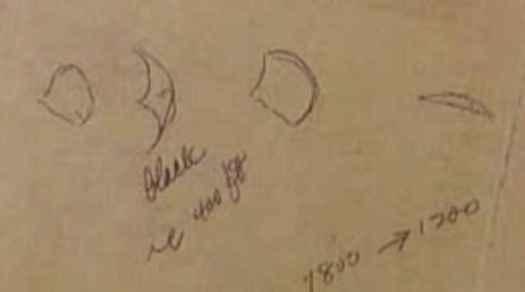 |
Arnold's
own sketch of the two types of objects he sighted on June 24, 1947.
The most famous were the eight "shovel-shaped" objects
that he described as "moving like saucers skipping on water"
- the source of the newspaper term "flying saucers." But
one object in the formation he sighted near Mt Rainier, Washington
was different. Second-from-last in the group of nine, this was the
bat-winged object shown in the artist's conception above.
Arnold's earliest sketch of the top view of this Horten-like object on the back of an envelope in the CUFOS files A similar drawing in the FBI files has a handwritten note that reads "one looked like this the second from last of the formation seemed a little smaller" FBI UFO FOIA files
|
Several of the Horten designs did in fact resemble early saucer reports, particularly the June 1947 Kenneth Arnold objects. The bizarre wing geometries of the Brandis aero-menagerie might well have made the notion of saucer-shaped experimental planes a bit easier to accept, particularly since the Soviets did base some of their earliest postwar prototype high-speed aircraft on some of the aircraft they recovered from Brandis.
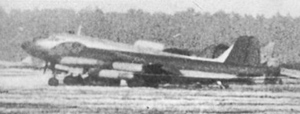 |
"Tourist photo" of Ju 287 V3/ prototype EF 131 in USSR. It was built by a joint Soviet/German design bureau called OKB-1 and flown at the Zhukovsky Flight Research Institute (LII) - with a German pilot at the controls - in 1947. Its distinctive wing shape may have attracted the attention of western observers in Moscow during test flights |
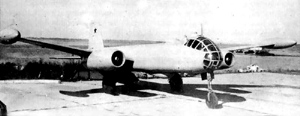 |
EF 140 - a Soviet improvement on the EF 131 design, now in Soviet markings, with two Soviet-designed engines and tip tanks to combat aeroelastic divergence |
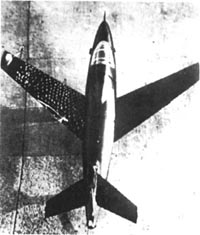 |
Soviet
forward-swept-wing transonic LL-3 rocket plane, circa 1947, designed
by P V Tsybin. It was a crude analog of the US Bell X-1
|
Photographic evidence
Below is a photo that purports to show the AS 6 in a hangar at Brandis circa 1944. When the photo was first published in the 1970s in the British journal Air Enthusiast, its authenticity was accepted by noted aerospace historian Bill Gunston. Note that the photo has been heavily retouched -- the floor has been painted over (the closer wheel is not circular and is smaller than the farther one) and some wing details have been overpainted or modified. The flaps look a bit suspicious -- the aileron appears to be sagging in such a way that if it were raised to be parallel with the wing, its tip would protrude in an inelegant way. On the other hand, the overall look of the craft is realistic and it seems to be a full-size aircraft rather than a model.
What is of particular interest in the photo are the background details, such as the signs reading "1. Staffeltrupp" and "Rauchen verboten" ("No Smoking") in addition to characteristic pipe and ventilation duct details.
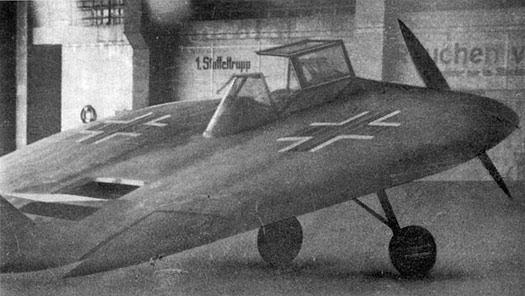
The two photos below were taken at Brandis apparently on or about April 20, 1945, by units of the US Army's 9th Armored Division, and show the Horten H 9 V1 glider prototype in a disassembled state in a hangar. (From other sources it seems that this glider was later destroyed by burning by US forces).
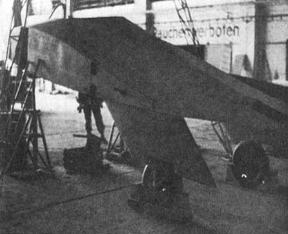 |
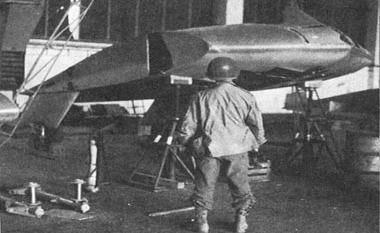 |
Note the "Rauchen verboten" sign and wall details in the background. While these may have been standard Luftwaffe hangar details, the general similarity is striking and tends to confirm the existence of the Sack plane at the same base as one of the Horten prototypes.
 |